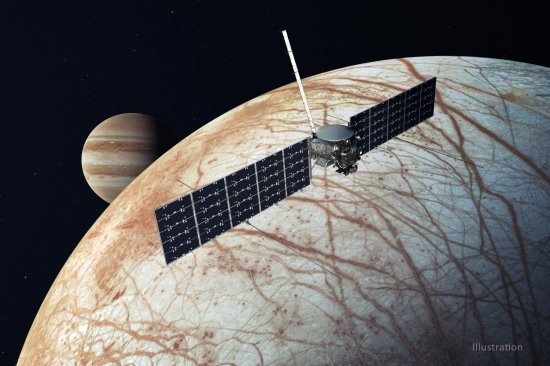
The Europa Clipper, set for launch in October, will explore a distant ocean world.
Nearly half a billion miles from Earth, a world may be stirring. Our planet is the only place in the solar system—and indeed the universe—where we know that life exists. But if the basic sciences of chemistry, energy, and biology apply, Jupiter’s moon Europa may be alive as well. On Oct. 10, NASA aims to start finding out, when it launches the $5 billion Europa Clipper spacecraft on a five-and-a-half-year journey to the Jovian system for the most detailed exploration ever of the mysterious icy moon.
Europa has fascinated astronomers and exobiologists for a long time—at least since 1979, when the Voyager 1 and 2 spacecraft reconnoitered the moon and photographed an icy white surface shot through with cracks and fractures, suggesting a churning ocean that was continually disrupting the frozen crust. The later Galileo mission, which orbited Jupiter from 1995 to 2003, helped confirm the existence of a global ocean, when it discovered that Jupiter’s magnetic field was disrupted in the vicinity of Europa in a way consistent with a deep, electrically conductive liquid beneath the surface of the moon. The Juno mission, which has been orbiting Jupiter since 2016, has been studying Europa more closely still, documenting ice walls, scarps, and ridges, all suggestive of a surface in constant motion. The moon’s two impact craters also froze in a rough pattern of concentric circles, pointing to ripples in the water below.
[time-brightcove not-tgx=”true”]Astronomers now believe that Europa has an ice shell 10 to 15 miles thick, covering a global ocean 40 to 100 miles deep. Sloshing around the entirety of the 1,940-mile diameter moon, that comes out to more than twice the quantity of water in all of Earth’s oceans combined.
While the temperatures in the vicinity of Jupiter can plunge to -400°F, the water in the ocean is kept liquid as a result of tidal forces: as Europa orbits Jupiter, it is held fast in the planet’s tight gravitational grip. But as its large sister moons—Io, Ganymede, and Callisto—repeatedly sail by, they pluck at it with their lighter gravity, causing the moon to flex and heat up, much the way a wire hanger bent rapidly back and forth will become too hot to touch at the point of the bend. Hydrothermal vents, which were first discovered on Earth in 1977 in the Galapagos Rift, may be scattered across the Europan seafloor too, further heating the water.
All of this produces a warm, pulsing, amniotic ocean, one that is believed to include salt, carbon, nitrogen, phosphorus, hydrogen, and sulfur—incorporated into Europa during the moon’s formation and imported aboard incoming comets and asteroids. Those elements make up 98% of all living matter on Earth, and with 4.5 billion years of stirring and cooking, they could on Europa too.

Europa Clipper is ingeniously designed to find out. The spacecraft, whose main body is a box about 20 ft. to a side, is stuffed with a suite of nine instruments, including optical cameras, temperature sensors, global radar, a magnetometer, and an ultraviolet spectrometer. None of those instruments are able to detect life, but they can all determine if Europa has the environment that could support it.
The spacecraft’s relatively small footprint gets a whole lot bigger thanks to its energy-producing solar panels. Out in the vicinity of Jupiter, sunlight is no more than 4% of what it is on Earth, and to produce enough energy to operate the instruments, the panels, which were attached to the spacecraft on Aug. 27, have to be huge. Each of two collapsible arrays measures 46.5 ft. long by 13.5 ft high, giving the total spacecraft a wingspan of more than 100 ft., slightly longer than a professional basketball court. Even at that, the panels will generate only about 700 watts of electricity, or roughly the energy required to run a small microwave oven or a coffee maker. Europa Clipper’s radar antenna, which sits perpendicular to the solar wings, adds more size still, rising 57.7 ft. from the body of the spacecraft.
All of that, plus fuel, means the spacecraft tips the scales at approximately 13,000 lbs., which requires a bruiser of a rocket to muscle it off the ground. Europa Clipper will get that rocket, in the form of the 27-engine SpaceX Falcon Heavy, with over 5 million lbs. of thrust, able to launch more than 37,000 lbs. on an interplanetary trajectory.
The spacecraft will not follow an as-the-crow-flies trajectory straight out to Jupiter. Rather, it will loop twice around the sun, passing Mars on Feb. 27, 2025, and swinging back past Earth on January 12, 2026. Both of those flybys will refine the trajectory and add speed to the spacecraft. Europa Clipper will finally reach Jupiter on April 11, 2030 for a minimum of four years of operation in the Jovian system. But all of that is for the beginning of the next decade. For now, Europa Clipper is being readied at NASA’s Kennedy Space Center to be loaded aboard its Falcon Heavy for the Oct. 10 start of its journey. The ship will be leaving one biologically teeming world and may well help discover another.